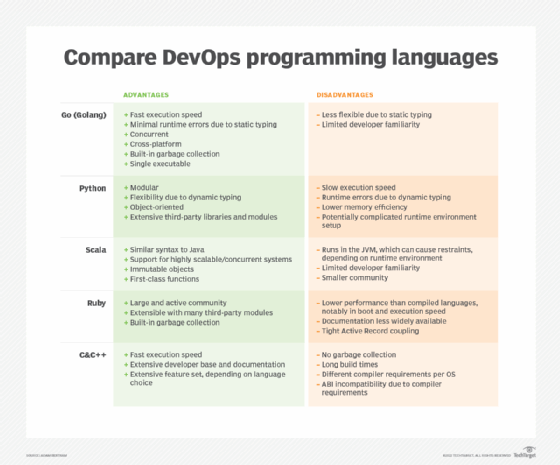
Getty Images
Compare Go vs. Python: What are the differences?
Golang and Python are both versatile, popular languages, but they have some important differences that developers should take into account when planning software projects.
Any developer knows there's no such thing as a perfect programming language. Each has upsides and downsides that should be carefully considered, depending on what's needed for a particular software project.
Python has long been a popular option for those looking to learn their first programming language due to its clarity and readability. Whereas many predecessors of Python use special characters for control structures and are syntactically complex, Python uses white space and has a simpler syntax that resembles spoken language.
More recently, Go -- also known as Golang -- has risen in popularity. With supporters praising Go's developer-friendly features, frequent updates and simple-but-elegant mindset, more and more programmers are choosing to learn the language.
Python and Go are both popular, versatile and suitable for beginners, but the two languages also have some important differences.

Syntax differences between Python and Go
Syntactically, Python is much simpler than Go. Instead of curly braces, Python uses changes in indentation to denote functions and control flow.
In the following example, which shows a function used to convert a string to uppercase, the tab space at the beginning of the second line indicates the function body:
def to_uppercase(string):
return string.upper()
In contrast to Python's use of white space, Go relies on curly braces to indicate the function body, a more familiar design for programmers coming from C-like languages. The following example, which shows the same function as above written in Go, illustrates this syntactical difference:
func toUppercase(str string) string {
return strings.ToUpper(str)
}
Unlike in Python, the tab space at the beginning of the second line in the Go example is merely for style and readability. Without the white space, the program would still execute normally.
Typing approaches in Python and Go
Python and Go have different approaches to variable typing: Python is dynamically typed, whereas Go is statically typed.
In the previous example of Go code, the function signature contains a type declaration: The types of the function's str argument and return value are both defined as string. In contrast, Python does not require type definition for function arguments.
Some programmers prefer a typing system like Go's, where the compiler can validate that functions have been called with the proper types before the application is executed. When a Go program is successfully compiled, a developer can feel more assured that the program will function as intended, since the compiler checks for the types passed to functions and any unused variables.
Because Python is an intrepreted, not compiled, language, it is executed without any of these preflight checks. As a result, Python programs can fail with many type-related errors that a Go program would catch during compilation.
Go vs. Python: Command-line tools and dependencies
Go programs use a built-in command-line tool called the go command. The go command can initialize new Go modules, download project dependencies and run test suites, among other uses described in the documentation.
While there are similar command-line tools for Python, they are not built into the language and can often be a source of frustration. Ask a Python developer about versioning, and you'll often get a response of exasperation, as there is no officially supported solution to manage Python versions.
Pyenv is an open source, third-party tool that can be used to manage multiple Python implementations. For dependency management, Python uses the package installer pip, which works well but not as well as Go's fully integrated package management.
For developers who enjoy having a comprehensive command-line tool to assist in many aspects of development, Go is certainly the better choice. Python requires more research, configuration and maintenance on the developer's part to set up their preferred solution for package management.
Concurrency and multithreading in Python and Go
Concurrency and concurrent programs are becoming more popular as developers look to maximize performance and scale.
Go is designed with concurrency at front of mind. Using goroutines, any function can run asynchronously, separate from the rest of the program. Python does support multithreaded execution, but it doesn't feel as polished and cleanly integrated as Go's goroutines.
In Python, a thread uses the OS' threads, which results in greater overhead per thread compared with goroutines. Instead of reaching out to the OS, goroutines use lightweight threads managed by the Go runtime.
The following is a basic example of a function written with multithreading in Python:
import threading
def myFunc():
print("Hello World!")
t1 = threading.Thread(target=myFunc)
t1.start()
Below, the same function is shown in Go:
func myFunc() {
fmt.Println("Hello World!")
}
go myFunc()
The Python program has to first import the threading library, then create a thread object and finally call start() on the thread object. In Go, however, any function can be called asynchronously with the go keyword, which runs the function in its own thread. As a result, a concurrent Go program is much simpler than an equivalent program written in Python.
Comparing Go and Python for containerized apps
Python is often slower than Go, as shown in the above threading comparison. This means there are some differences between Go and Python worth considering when working with containerized applications.
A key advantage of container architectures is the ability to scale an application quickly. Therefore, when working with containers, it's also most effective to choose a language that runs quickly. As a faster, more lightweight language, Go has the advantage over Python in a containerized tech stack that uses platforms such as Docker and Kubernetes, which are themselves written in Go.
Go vs. Python: Main takeaways
Go is a better language for concurrent programs, with a simpler, faster way to manage multithreaded functions. Go also provides the go command, as well as a built-in command-line tool to assist developers with writing, running and testing Go code.
Python, on the other hand, is a great language for those starting out, with easy-to-read syntax and many learning resources for beginners. Given its lack of a command-line tool, Python may not be as developer-friendly as Go, but it does have the advantage of a longer history and, therefore, more support for third-party tools and frameworks.
Python still holds a space for many who prefer a dynamically typed, interpreted language. As a multipurpose and versatile language, Python is well suited for general-purpose programming and is extensively supported by many libraries to do just about anything you can imagine. If you want a more purpose-built software development language, Go is faster than Python, offers better concurrency and has many built-in developer features.





